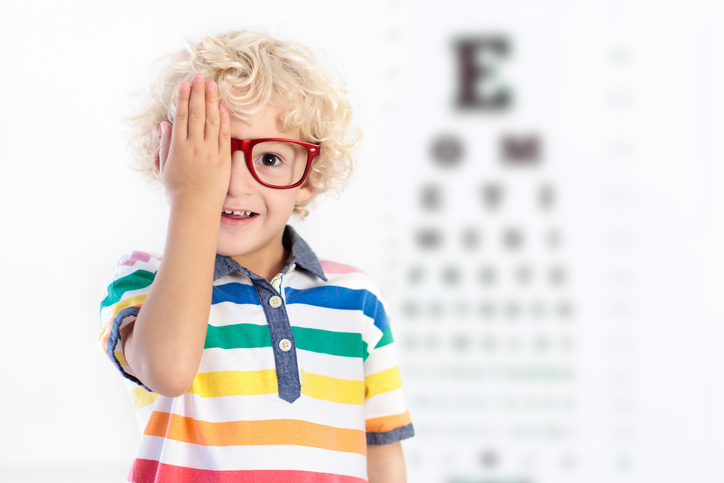5 Ways to Keep your Child’s Eyes Safe


HOW TO SUPPORT EYE DEVELOPMENT
Just like any basic ability, eyesight develops over time. Your child’s vision develops significantly in the first eight months of life. The eyes must learn to focus, work together, and send the brain messages about the world. If these skills aren’t developing correctly, the chances of other developmental issues increase. Ensure that your child’s vision is developing properly by taking the following measures:
From birth to four months old, change the position of your child’s crib in his or her room regularly. Keep a nightlight or dim lamp in the baby’s room and talk to him or her as you move around the room. When the child is five months old, hang a mobile in the crib and allow plenty of exploration on the floor. Playing games like patty-cake also benefit development and hand-eye coordination.
At six months old your baby is ready for a full eye exam, but there is still developmental work to do. When your child is a year old, play hide and seek games like peek-a-boo, roll a ball back and forth for your child to visually track, and begin storytelling to facilitate visualization. When your child turns two, eyesight and hand-eye-foot-body coordination should be fully developed. However, it is essential to continue paying attention to your child’s eye safety.
HOW TO PREVENT EYE-RELATED ACCIDENTS
“Accidents involving common household products cause 125,000 eye injuries each year” (preventblindness.org). Most of these injuries can be prevented. Some major causes of common eye injuries include the misuse of toys, accidents from falling, and contact with harmful household products like forks, pens, detergents, and paints. Read toy labels attentively and avoid toys with pointed edges. Most importantly, use safety gates, cabinet locks, and corner cushions to eliminate hazards. Erring on the side of caution can take care of many potential dangers, but children are still at risk for different eye infections.
HOW TO RECOGNIZE SYMPTOMS OF AN EYE INFECTION
Children touch anything they can get their hands on which means they’re especially vulnerable to eye infections. Red, encrusted, swollen, itchy eyes are usually indicators of a health concern. Since babies and toddlers can’t clearly vocalize their problems, watch out for consistent eye rubbing. These symptoms may be caused by a virus or infection like keratitis or conjunctivitis. If your child seems to have extreme sensitivity to light, it could be due to elevated pressure in the eye. Constant eye-rolling may be related to muscle control, and excessive tears can indicate a blocked tear duct. Pay attention to your child’s eyes and visit the doctor if any of these symptoms arise. In addition to infection, environmental factors can also pose a threat.
HOW TO AVOID OUTSIDE DANGERS
Household products and bacteria aren’t the only factors that can cause eye issues. Many outside elements can damage the eyes too. The sun’s rays can harm children’s eyes as they develop. Choosing a protective pair of sunglasses is crucial. When selecting glasses, choose a pair that filters UVA and UVB rays. The shades themselves should keep colors natural: no hot pink or blue lenses. Make sure the glasses fit your child comfortably, also taking into account his or her active lifestyle. Glasses easily fall off and break, so choose a pair that is suitable for whatever activities your child engages in. Wide-brimmed hats can also provide extra protection by reducing the number of UV rays that reach the eyes.
If your child engages in sporting activities, more protection is needed. “Every 13 minutes, an emergency room treats a sports-related eye injury. And, 43 percent of sports-related eye injuries are to children ages 14 and younger” (preventblindness.org). Ensure your child is wearing a helmet and eye-wear when engaging in sports. Dr. Davidorf highly recommends wearing protective eye equipment during any sporting activity, especially when playing with toys like BB guns.
HOW TO ENCOURAGE EYE EDUCATION
As your child ages and grows more independent, you may have less control over his or her eye health and safety. For this reason, it is important to educate your child about healthy vision and how to care for his or her own eyes. To begin providing your child with a proper understanding of eye health, you can use a variety of online resources that are informative and kid-friendly. Here are a few examples:
• Printables
• Activity Sheets
• Ask A Scientist
Dr. Davidorf’s most urgent tip: “get adamant and get checked while still young, because after seven or eight years old, you can’t make much headway.”
There are many components to consider when protecting your child’s eyes. By staying proactive and aware you can maintain your child’s good eye health. Laser Locators wants to ensure you know the facts when it comes to eye health and safety. Support your child’s eye development, prevent household incidents by child-proofing, recognize symptoms of eye issues, provide protection from the sun and sports, and encourage eye education. Annual eye exams are critical, but so is prevention and protection. Set a positive example by showing your kids that overall eye health and safety are required all year long.
